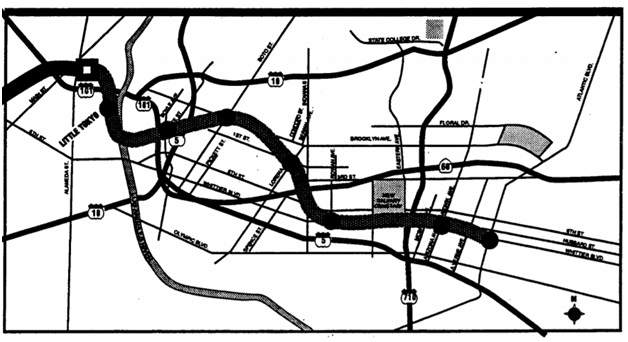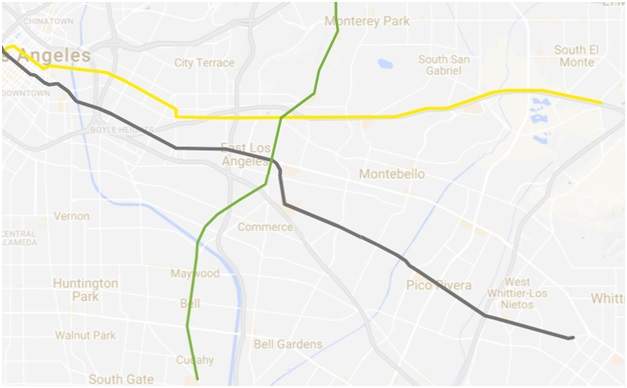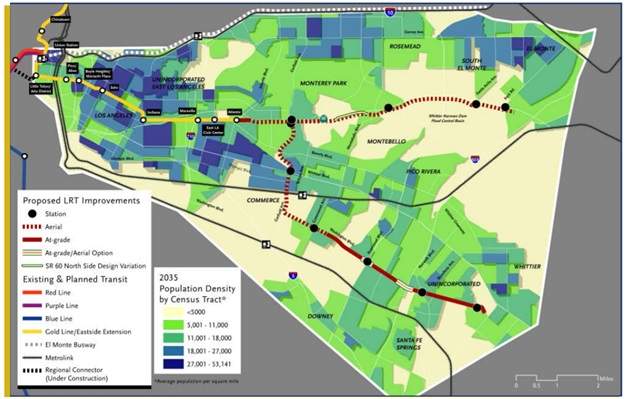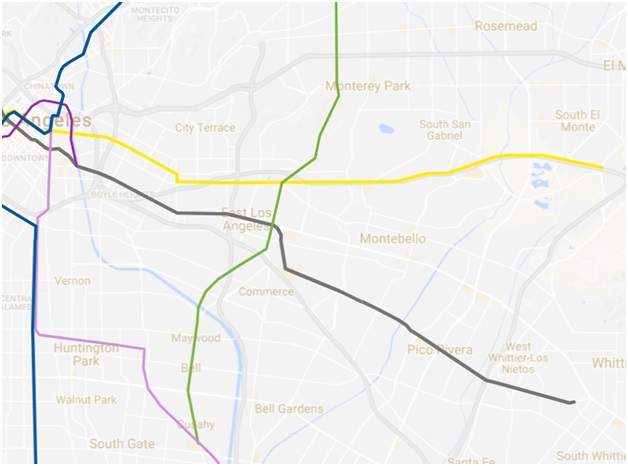At this month’s board meeting, Metro’s Directors approved the alternatives for the final environmental study of the Gold Line extension. The project, which has $6 billion in funding from Measure M, will extend light rail from its current terminus at the intersection of Pomona and Atlantic to the cities of Whittier and South El Monte.
This branching configuration, also known as the combined alternative, was formally approved by the directors following a technical study by staff that indicated service could be operated on both branches with some key changes to the existing proposal. The combined alternative would require the construction of an underground three-way junction, allowing for a new service from the South El Monte terminus of the SR-60 route to the city of Whittier that would bolster frequencies on the extension.
The extensions were widely heralded by board members and the public, with the exception of a few comments to the effect that the Washington Boulevard route should not have to share with the SR-60 route. To the extent that there was any consternation with the project, it was not with respect to its design, expense or low ridership, but merely to its construction timeline. Chair Fasana introduced a motion that staff should report back on any means possible of accelerating both branches of the Gold Line extension, one of which is slated to open in the 2030s with the following in the distant 2050s.
The extension, as noted previously, is intended to solve a political problem: how to secure support from the San Gabriel Valley COG and the Gateway Cities COG for a rail line that cities in both jurisdictions have been fighting over since the early 2010s. From the political vantage, branching is a neat solution. Because neither side has lost the Gold Line, both sides are winners. The tautology should be a red flag that the means to an end (“we can address transit issues by building a rail line”) has become an end unto itself (“we can address the absence of a rail line by building a rail line”). Whereas the former statement admits of an ecosystem of existing transit riders, their needs, and the shortfalls of the current system, the latter statement is self-contained and trivial. The quality of the project and its utility as a public service for riders has apparently vanished from the discussion.
Could the project be improved? I think, even at this late stage, the answer is that it could be made significantly better for riders. There should be no mistaking, though, that the political climate is not favorable to making changes to Metro’s big ticket construction projects. The county’s various constituencies overwhelmingly approved the timeline of Measure M’s expenditures, but none of them are satisfied with a decades-long wait for their region’s project. Measure M contains stipulations safeguarding the money of one COG from being expended in another, and likewise preventing one project from being accelerated if it means another will be delayed. Despite all this, Metro continues to suggest in broad terms that most projects can be built before their planned delivery date. This focus on expediting the pre-construction process means that attempts to revise the plans for a project, even in an attempt to improve them, will probably be seen as adversarial. This is true even though there are theoretically many years before building will actually begin.
With that in mind, let’s look at a few of the many ways that the Gold Line extension could be improved from its current state. The first is the extension of the subway system to the city of Whittier via Whittier Boulevard. This alternative, roughly reflective of the MTA’s original plan in the 90s, is proposed often in transit circles (including by me here). Without rehashing the entirety of how the subway was axed, I want to focus on two points with respect to this plan.
First, the Red Line extension from the 90s had a swooping S-shape through Boyle Heights down to the intersection of Whittier and Atlantic, making it both slower and more expensive than it needed to be. Nonetheless, it projected for a ridership of 52,000 riders per day, as compared with a 2020 projection of 16,000 riders for the Eastside Gold Line, which presently carries 13,000. Speed and convenience are such drivers in transit choice that shifting the Gold Line north less than a mile resulted in Metro leaving 75% of available ridership on the table.
The second point is simply this: The Purple Line extension is dead, and transit advocates should invest their energy elsewhere.
The costs for the next phase of the Gold Line extension are being split by the Gateway Cities and the San Gabriel Valley COGs. But any plan to restart the subway extension would need to start in Los Angeles, further to the west. In case it is not self-evident that this would not go over well, Senator Tony Mendoza in the southeast is attempting to reconfigure Metro’s board for the third time in two years, owing predominantly to sentiments that Los Angeles is overrepresented in transit matters. The available funding is insufficient to tunnel the 13 miles between the DTLA Arts District and the city of Whittier, meaning the COGs would have to accept delays to their project while a first phase was constructed in Los Angeles and East LA. Considering many in the area see the project as a Measure R item that has been on the backburner, this is frankly not happening. The final issue is that because the COGs are funding the project jointly, any proposal that does not also serve the San Gabriel Valley is dead on arrival.
So instead, let’s look at imperfect solutions that improve the project while checking the necessary political boxes. It has been suggested in the comments that Metro could improve the project by eliminating the branching, and putting a forced transfer from the Washington Line to the Gold Line at Atlantic station. Such a line could eventually be extended to Pasadena, or even into the San Fernando Valley to meet up with the Orange Line. There is clear value in building a north-south connection in the San Gabriel Valley, even though it is of a secondary importance to supplementing the more dominant east-west travel pattern. Since Metro is studying a C-shaped line between South El Monte and Whittier to shore up frequencies on the branches, we shouldn’t be scared off by the prospect of a transfer. In practical usage, riders on the Gold Line as presently proposed are likely to be forced to transfer on their way to downtown or points west anyway. The knock against this proposal is its meandering route, potentially a major issue since it connects Pasadena, a secondary center, to several smaller centers of activity. Ideally, we would want this route to be as cheap and direct as possible, but in practical terms it is probably still preferable to the combined alternative.
However, my favored alternative for resuscitating the Gold Line extension would be to fully split Metro’s proposal into its component parts. In such a setup, there would be three separate routes:
- An extension of the present Gold Line along the proposed route parallel to the 60;
- Following the proposed path of the Washington Alternative to Whittier/Atlantic, and then following Whittier Boulevard westward in an underground alignment as a new east-west line through downtown Los Angeles;
- A north-south line roughly following Atlantic Boulevard between Pasadena and the West Santa Ana Branch.
As can be seen in the map, the SR-60 alternative is probably the most accessible extension of the Gold Line. It would be fast, it has political support, and, while it’s expensive on a per-rider basis, in absolute terms, it’s fairly cheap. In Measure M, the branch following the 60 was budgeted at half the cost of the Washington Boulevard alignment, and costs have escalated for the latter since then. Community support is a major factor, and as I’ve mentioned, it seems likely that even an attempt to improve the route would engender some amount of pushback. If we can eliminate the branching, and thereby make service to South El Monte as good as service to Santa Monica, then we should consider that a victory.
The Washington Boulevard alignment also uses the exact path that will be studied in Metro’s FEIR, and for the same reasons. The revised Washington alternative has below-grade stops at Whittier/Atlantic, the commercial heart of East Los Angeles, and Commerce’s Citadel Outlets, a major trip generator on the Eastside. These could be the building blocks of a strong rail project. The issues with the alignment as studied by Metro are poor service due to branching, and poor connectivity to downtown Los Angeles and points west. Because the Gold Line is slow in Boyle Heights (Google pegs it at about 15 miles per hour between Little Tokyo and Atlantic), and because the Washington Boulevard alignment must jog far off course to meet up with it, riders from East LA and Whittier will have to endure long rides to get to their likely destinations. Under the presently proposed structure, Metro will see patrons opting to alight at Whittier/Atlantic for a transfer to the 720, which serves job centers more directly. To remedy this, I would propose rectifying a historical error in the development of Los Angeles’ rail network. The Washington Boulevard branch should be reestablished as a separate rail line to downtown, with a below grade segment along Whittier Boulevard. Boyle Heights and East Los Angeles form the densest, most commercially active part of Whittier Boulevard.
Whittier also provides a more direct route into the city, making it faster and more attractive to riders. In DTLA, a first phase of this line could offer transfers to the subway at 6th/Santa Fe. If extended along 4th street, it could terminate beneath the prospective infill station for the Regional Connector at 5th and Flower. This alternative also has the benefit of further extensibility, lining up nicely for a westerly extension along Beverly Boulevard, through several of the county’s densest residential areas.
Finally, the north-south line following Atlantic, which itself cobbles together several existing service proposals. While Metro has voted to declare traffic management the locally preferred alternative for the 710-North project, the north end of an Atlantic line would be wholly within the study area for that project, and, in my opinion, a stronger light rail route than the route proposed by Caltrans, which mostly skirted commercial areas. On the south end, Director Solis has instructed staff to identify a rail corridor that could connect the Gold Line extensions to the West Santa Ana Branch corridor. Again, Atlantic seems ideally suited to the task, if we want to provide a connection that is short and, therefore, cheaper to build. The link from the northern branch of the Gold Line to the West Santa Ana Branch would be 6 miles following Atlantic, compared with 8 miles along Garfield and over 11 on Rosemead Boulevard.
In sum, this proposal, shown below in relation to other Metro lines, would improve rail service to both Whittier and South El Monte, while preserving large parts of the existing plan that have established political and community support. As a result, it would also eliminate the appearance of a political about-face for Metro’s directors. If nothing else, it suggests that a political compromise aimed at achieving better transit could still be achieved for the Gold Line extension.
Scott covers transportation and governance issues from his home in Silver Lake. Follow him on Twitter @safrazie.
- The Eastside's Six Billion Dollar Question (Urbanize LA)









